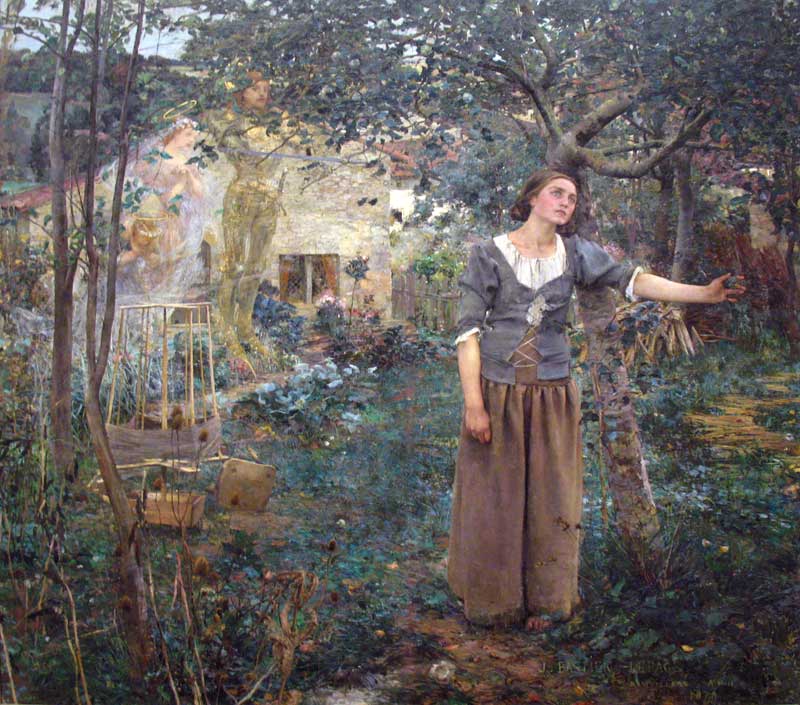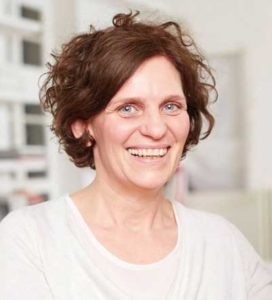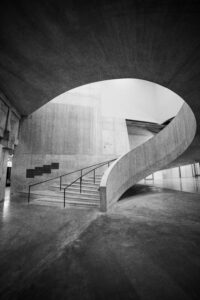Consciousness of creativity
Author: Kun Ya Andrea Schmidt
Co-creativity is not just about me and the other, but draws from an integral consciousness in harmony with the whole environment. As an architect, the author draws particular attention to collaboration with the earth in the design of a building. Or does the place even want to be built on? Successful works of art and architecture succeed in integrating the transcendental level. The awake spirit senses this.
No work of art from painting has ever moved me more than the painting Joan of Arc (Johanna von Orléans) by the French painter Jules Bastien-Lepage (1848-1884) from 1882. Years ago I stood before it. It still reaches to my emotions today. The painting has an indescribable mysticism, a mysterious aura. I see the expression on Joan of Arc’s face as if it were yesterday, the wonderful blue eyes gazing into the far distance, seemingly seeing through everything, full of knowledge, power and impressive closeness.
At the same time, I feel her vulnerability. Her outstretched arm and the posture of her hand suggest something infinite, or – one might think – reaching into the divine, connecting with a healing, expansive energy. A powerful gesture.
Pain, hope, confidence and love touch the hearts of the viewers at the same time.
In architecture we can also experience such moments of complete emotion. These are mainly buildings or places that let you participate in their power, the spirit of the place and the idea for which they were built in the first place. The commonality of these buildings forms a complete bond with the place, almost as if they merge with it. They are a real unity.
 Jules Bastien Lepage – Joan of Arc
Jules Bastien Lepage – Joan of Arc
The Matrimandir in Auroville, South India, for example, was built as a place of silence that allows the unity of heaven and earth to be experienced. In no other place in this world have I felt a comparable realization. The building simply places its visitors in this oneness. Whether one wants to or not, an awareness of oneness, of vastness, of silence, of depth, of connectedness, of heaven and earth penetrates every cell of one’s being. The body relaxes, the mind becomes peaceful and calm, the soul comes very close. Any resistance or possible struggle against it, no matter how powerful, is extinguished. The creator of this sublime architecture is Mirra Alfassa (1878-1973). Later called “The Mother,” she was a spiritual companion of the philosopher and yogi Sri Aurobindo and founder of the Auroville project.
Another example is the Jewish Museum in Berlin. I had the opportunity to participate in a tour of the shell before it opened. Although there was not a single exhibit on display, the building by itself managed to draw me into that terrible time and into the images of that time, as if it became real for moments. Now, with actual exhibits, photos and such on display, the effect is even more dramatic, making the time real for all visitors.
Likewise, there are comparable examples in music. Here we can probably experience the most moments of complete emotion, and always when the performer deeply touches the hearts of the listeners, when the music goes through and through, threatening to tear us apart in the heart, because we feel the message in the form of pain, joy, longing or love within us. This music not infrequently moves us to tears. Everyone has experienced this. Adele, for example, is an artist who manages to touch people with almost every song. Her audience is huge. And she is one of many artists who can do that.
THE CREATIVE POWER OF CONSCIOUSNESS
In spiritual traditions, consciousness has always been there. We can access it continuously. It permeates all realms of existence and is never separate from anything. This is because each of us is free to choose for ourselves, in our own personal state, what we want to be conscious of or not. Physical consciousness, emotional consciousness, soul consciousness. Universal higher consciousness, subconsciousness, unconsciousness, superconsciousness and so on. It is always all there at the same time, in every place, in every dimension. There are no boundaries. Even the levels of consciousness merge smoothly. So consciousness is always happening presently and in connectedness. It forms a unity with all things, thus it permeates everything. And because it is the precondition of everything, it is a form of being-there, from which creation can arise.
Consciousness, then, always happens presently and in connectedness.
If consciousness is a fundamental form of existence, this means at the same time that we cannot learn or practice noticing consciousness. We can practice mindfulness. It is a kind of concentration in which we decipher, define, classify, judge, evaluate; and we do so even when we are trying hard not to.
Consciousness for creativity
For as soon as one practices to perceive attentively, alertly, mindfully, one necessarily becomes an observer. But an observer is always separate from what he observes. There is no unity between the two poles. The observer remains almost aloof in the background.
Observing alone is not a creative force. Nor is it the same as being conscious. Observing strengthens the sense of self. We are focused on ourselves and strengthen our ego. Therefore, practicing mindfulness can only be the first step into a creative consciousness.
This step is fundamentally important because by becoming mindful in what we think, feel and do, we experience very brief moments of awareness over and over again. We just must not make the mistake of confusing becoming aware with consciousness in this process.
Consciousness means being in connectedness, in oneness. To become aware of this, we need the level of our heart.
THE POTENTIAL OF CO-CREATIVITY
Integral awareness for cooperation, teamwork or community in general is significant, because no one person alone can find the solutions our world needs in today’s world. Forces have to join and people have to find each other purposefully.
That is why co-creativity is timely and very important. But in the general understanding of co-creativity it rather refers to the empathic, the social togetherness and is connected with an open and appreciative attitude towards the impulses of the other. It is also about creating a fear-free environment, strengthening a mutual motivation and eliciting commitment.
In an integral awareness, however, the potential of co-creativity lies somewhere else entirely: in awareness of the larger context, each participant also recognizes here the larger purpose for the project, his or her role in it and, above all, his or her responsibility.
Quite independently of personal, emotional or learned competencies, it may well be that the essence, the soul field of the individual participants demands and promotes previously unknown abilities or perceptions for the project. Here are not necessarily meant abilities like better listening, talking or combining, here are meant soul abilities, which concern the spiritual energetic potential of the individual.
CO-CREATIVITY, CONSCIOUSNESS AND MEDITATION
This also includes existing development paths. The consciousness, which conveys itself to the perceiver via the energy of the heart, is a level of perception and action at the same time. A level, however, which is so intimately connected with the observer of things that its describability very often eludes real objectifiability: Because the energy of the heart, which is experienced as joy or love, already influences the subtle when perceiving. Thus all approaches of cause and effect are reverse.
In a co-creative work, therefore, the potentials of all players and the order of their applicability in the sense of the development process are found. This means that not only the project develops, but each participant takes a step in consciousness.
This abandonment of the principle of cause and effect is the prerequisite for experiencing integral consciousness. This is best achieved in meditation
Consciousness for creativity
Here we tread the path of going within and participate in the perpetual flow of life, the lawfulness in whose nature everything moves. Mind and feeling connect with the soul.
Provided that one chooses a form of meditation that is not static, such as the pure practice of mindfulness. The form of meditation that awakens integral consciousness involves steps of transformation. It teaches light consciousness as well as deep inner stillness. It teaches to use the heart level as a perceiving and acting organ, to stimulate or accelerate the process of transformation. At the same time, it provides solutions. Solutions that reveal themselves from the inner universes of the meditators.
Om namah shivaya
 About the author
About the author
Kun Ya Andrea Schmidt, born 1967, is a spiritual teacher and architect, co-founder of Integral Vision and the Center for Kan Yu, a teaching of deep consciousness. She has been teaching Soulful Meditation to individuals and in businesses for over 30 years.
This article appeared originally on the German Homepage Tattva Viveka: Bewusst-Sein für Kreativität






